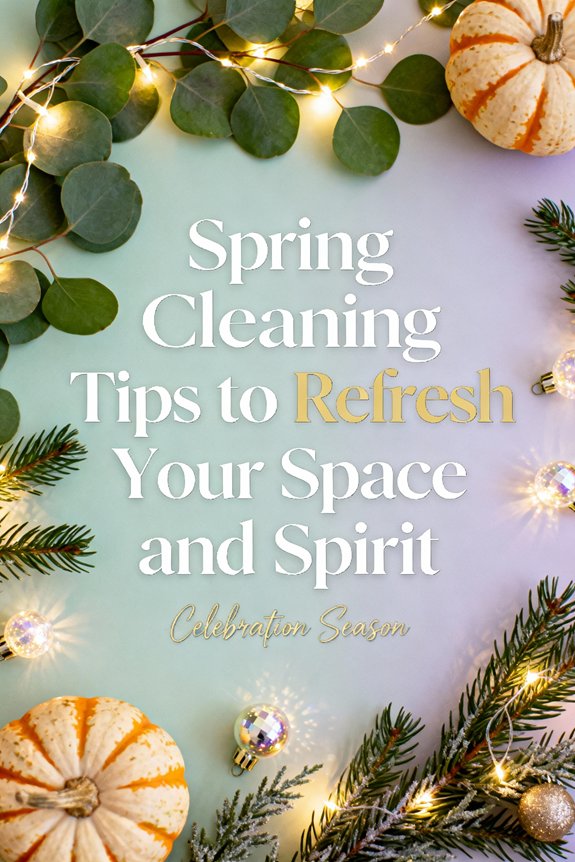Start your spring cleaning by tackling one room at a time to avoid overwhelm. Begin with decluttering—sort items into keep, donate, and discard piles before you even pick up a cleaning cloth. Open windows for fresh air circulation while you deep clean forgotten spaces like baseboards and behind appliances. Use natural solutions like vinegar and baking soda for healthier cleaning. Label storage areas as you organize to maintain order. Document your progress with before-and-after photos, and you'll discover specific weekend projects that change your space completely.
Key Takeaways
- Tackle one room at a time with a checklist to avoid overwhelm and maintain focus on surfaces, storage, and floors.
- Declutter before cleaning by removing items that don't belong and sorting them into Keep Here or Action Required categories.
- Open windows for cross-ventilation to eliminate dust, odors, and chemical fumes while creating a fresh, welcoming atmosphere.
- Use natural cleaning solutions like vinegar, baking soda, and lemon to protect health, save money, and reduce plastic waste.
- Document progress with before-and-after photos and celebrate milestones to stay motivated and maintain your refreshed space long-term.
Start With a Room-By-Room Strategy to Avoid Overwhelm

When you tackle your entire home at once, you'll likely abandon the project halfway through. Instead, create a room checklist that breaks down your space into manageable sections. You'll maintain momentum and see real progress.
Start with the room that bothers you most—whether it's your cluttered bedroom or chaotic kitchen. Identify three focus areas within that space: surfaces, storage, and floors. Clear countertops and tables first, then organize cabinets and drawers, and finish by cleaning from top to bottom.
Complete one room before moving to the next. This approach gives you a sense of accomplishment that fuels your motivation. You're not alone in feeling overwhelmed by spring cleaning—we all need structure to succeed.
Schedule specific days for each room on your calendar. When friends ask about your weekend plans, you'll proudly share your cleaning victories.
Revamp your home one room at a time, and you'll actually finish what you started.
Declutter First, Clean Second for Maximum Impact
Before you spray a single surface or vacuum one corner, remove everything that doesn't belong in the space. This decluttering approach changes your cleaning from frustrating to fulfilling. You'll discover surfaces you'd forgotten existed and make every cleaning effort count twice as much.
Apply proven decluttering techniques by sorting items into clear categories:
| Keep Here | Action Required |
|---|---|
| Everyday items | Donate unused items |
| Seasonal decor | Relocate misplaced belongings |
| Functional tools | Repair broken objects |
| Sentimental pieces | Discard trash immediately |
Once you've cleared the clutter, your cleaning priorities become obvious. You'll spend less time moving objects around and more time actually cleaning. This method prevents you from simply spreading dirt around your possessions.
Start with one drawer or shelf if a full room feels overwhelming. You're building momentum with each decision. Small wins lead to changed spaces, and you'll feel the difference immediately. Once your space is refreshed, consider organizing seasonal decor properly so your next celebration setup becomes effortless.
Open Your Windows and Let Fresh Air Work Its Magic

As soon as you've cleared your surfaces, crack open every window in the room to create cross-ventilation. This simple act changes your cleaning routine from ordinary to extraordinary. Fresh air benefits extend beyond just pleasant scents—they actively eliminate trapped dust particles, chemical cleaning fumes, and stale odors that've settled into your fabrics and corners.
Position fans strategically to push air through your space, creating a natural circulation system. You'll notice how this seasonal rejuvenation instantly lifts the atmosphere while you work. The flowing air also helps dry surfaces faster, reducing mildew risk and speeding up your cleaning process.
Time your window-opening sessions during mild weather days, typically mid-morning when outdoor air quality peaks. Even fifteen minutes makes a difference.
This practice isn't just about cleanliness—it’s about creating a space where you and your family truly want to gather. Fresh air connects your indoor environment with the revitalizing energy of spring outside.
Deep Clean Forgotten Spaces That Harbor Winter Grime
While you've been diligently wiping counters and vacuuming floors, months of winter grime have accumulated in spaces you haven't touched since fall.
These hidden corners deserve your attention now, especially since they're breeding grounds for seasonal allergens that affect your family's wellbeing.
Target these overlooked areas systematically:
- Behind and under appliances – Pull out your refrigerator and stove to vacuum dust bunnies and scrub sticky residue that's been building up all winter.
- Inside light fixtures and ceiling fans – Remove glass covers and wipe down blades where dead insects and thick dust layers have settled.
- Baseboards and door frames – Scrub these often-ignored surfaces with warm soapy water to remove accumulated grime.
You'll be amazed at how much cleaner your home feels once you've tackled these neglected spots.
Declutter as you go, discarding items you've forgotten about. Your space will finally breathe again.
Use Natural Cleaning Solutions for a Healthier Home

You'll eliminate harmful chemicals from your home by switching to natural cleaning solutions made from simple pantry staples.
These eco-friendly alternatives—like vinegar, baking soda, and lemon—cut through grime just as effectively as commercial products while protecting your family's health.
Create three basic DIY cleaners to tackle every surface: an all-purpose spray, a scrubbing paste, and a glass cleaner.
Benefits of Natural Ingredients
Natural cleaning solutions eliminate toxic chemicals from your home while delivering powerful results against dirt, grime, and bacteria.
You'll discover that eco friendly options like vinegar, baking soda, and lemon aren't just safer—they're exceptionally effective at cutting through years of accumulated mess.
The comprehensive benefits extend beyond surface cleanliness:
- You'll protect your family's respiratory health by removing harsh chemical vapors that linger in enclosed spaces.
- You'll save money since these pantry staples cost considerably less than commercial cleaners.
- You'll reduce plastic waste by reusing spray bottles and containers.
These natural ingredients work systematically to break down buildup without leaving harmful residues.
You're joining countless others who've changed their cleaning routines into wellness practices that nurture both home and health.
DIY Cleaner Recipes
Because commercial cleaners accumulate under your sink and create their own form of clutter, you'll simplify your routine by mixing three essential solutions that tackle 90% of household cleaning tasks.
Start with an all-purpose spray: combine equal parts water and white vinegar in a bottle, then add ten drops of lemon essential oil. This mixture handles countertops, appliances, and mirrors. The vinegar uses include cutting grease and disinfecting surfaces, while essential oils benefits extend beyond fragrance to antimicrobial properties.
Next, create a scrubbing paste using baking soda, castile soap, and tea tree oil for stubborn stains.
Finally, mix water with lavender essential oil for a rejuvenating floor cleaner.
Label each bottle clearly and store them together—you're now part of a community choosing simplicity over excess.
Organize as You Go to Create Lasting Systems
Organizing during your spring cleaning session prevents clutter from returning once you've created a clean slate.
Start by labeling every container, drawer, and storage bin you fill—clear labels eliminate guesswork and guarantee items return to their designated spots.
Build on this system by implementing a five-minute daily decluttering routine where you immediately address misplaced items before they accumulate into overwhelming messes.
Label Everything You Store
A storage system fails the moment you forget what's inside each box or bin. You'll waste time searching and likely create new clutter in the process.
Effective labeling systems convert your storage solutions into functional tools you'll actually use.
Make labels work for you:
- Use clear, specific descriptions – Write “Winter Sweaters – Medium Weight” instead of just “Clothes”
- Add dates to seasonal items – You'll know exactly when you stored holiday decorations or summer gear
- Label multiple sides – Mark at least two sides of each container so you can identify contents from any angle
Invest in a label maker or use waterproof markers on masking tape.
Your future self will thank you when you're not tearing through storage areas wondering where you packed that item.
Maintain Daily Decluttering Habits
While spring cleaning creates immediate results, those results disappear within weeks unless you build maintenance into your routine. Alter your space permanently by implementing simple daily routines that prevent clutter from accumulating.
| Time of Day | 5-Minute Action |
|---|---|
| Morning | Make your bed and clear nightstand surfaces |
| After meals | Wash dishes immediately and wipe counters |
| Evening | Sort mail, recycle junk, file important papers |
| Before bed | Return items to designated homes throughout house |
These micro-habits prevent decluttering challenges from overwhelming you later. You're not alone in struggling with maintenance—we all face the same daily battle against chaos. Start with one habit this week, then add another. Small, consistent actions create the organized home you deserve.
Tackle One Major Project Each Weekend

Breaking down your spring cleaning into weekend-sized chunks changes an overwhelming task into manageable progress.
You'll find weekend motivation builds naturally when you're tackling just one focused area instead of scrambling everywhere at once. Smart project planning means selecting areas that'll give you the biggest visual and functional impact.
Choose your weekend projects strategically:
- Deep clean your kitchen – empty cabinets, purge expired items, scrub appliances inside and out, and reorganize based on what you actually use
- Transform your closet – remove everything, sort ruthlessly, donate what doesn't fit your life anymore, and arrange what remains by category
- Reclaim your garage or basement – create keep/donate/trash zones, consolidate similar items, and establish clear storage systems
You're not just cleaning; you're creating spaces that support the life you want.
Each completed weekend project builds momentum for the next, turning spring cleaning from a dreaded chore into an achievement you'll actually feel proud of. Just as meal kit services simplify weekly planning by breaking tasks into manageable steps, applying this same focused approach to spring cleaning transforms overwhelming household projects into achievable weekend wins.
Celebrate Your Progress and Maintain the Momentum
Once you've completed each weekend project, document your change with before-and-after photos that'll remind you why the effort mattered. Progress tracking alters abstract effort into visible achievement, reinforcing your commitment to a clutter-free space.
Build momentum through these motivation techniques:
| Milestone | Reward Action | Maintenance Step |
|---|---|---|
| Room completed | Share photos with friends | 15-minute daily reset |
| Closet organized | Buy yourself flowers | Weekly 5-minute check |
| Garage cleared | Host gathering | Monthly quick audit |
| Whole home done | Plan celebration dinner | Seasonal refresh |
You're part of a community that values intentional living. Connect with fellow spring cleaners online to share victories and strategies. When you feel your energy waning, revisit your documentation—those alteration photos prove you're capable of maintaining order.
Schedule quarterly mini-refreshes to prevent backsliding. Sustainable change happens through consistent, small actions, not perfection.
Frequently Asked Questions
How Often Should I Replace Cleaning Tools Like Mops and Sponges?
You'll want to replace sponges every one to two weeks for proper sponge sanitation, especially if you're tackling daily messes with your cleaning crew.
For mop maintenance, swap out mop heads every two to three months, or sooner if they're visibly worn. You can extend their life by sanitizing them weekly in hot water or bleach solution.
Keep backup supplies stocked so you're always ready to tackle clutter with fresh, effective tools alongside your household team.
What Should I Do With Sentimental Items I Don't Use?
Create a dedicated memory storage system for sentimental items you don't use.
Take photos of bulky pieces, then release the physical item while keeping the emotional attachment alive digitally.
Store your most treasured keepsakes in one beautiful box—if it doesn't fit, it's time to curate.
You're not alone in this struggle; we all face these decisions.
Can I Spring Clean if I Have Pets or Allergies?
You'll thrive with pet-friendly cleaning solutions and allergy-friendly products designed for your needs.
Start by decluttering one room at a time to minimize dust exposure. Use fragrance-free, natural cleaners that won't irritate airways or harm your furry companions.
Vacuum with HEPA filters, wash pet bedding weekly, and open windows for ventilation.
You're part of a community that prioritizes health while maintaining clean homes.
Take breaks, wear a mask if needed, and celebrate each small victory together!
How Do I Motivate Family Members to Help With Cleaning?
Make family teamwork work by offering cleaning incentives that appeal to everyone.
Start with a clutter-focused plan: assign specific zones to each person, set a timer for 30-minute sprints, and celebrate progress together.
You'll find success when you create friendly competitions or reward completed tasks with family movie nights or treats.
Break overwhelming projects into manageable steps, and you're building household habits that bring everyone closer while maintaining your shared space beautifully.
Should I Hire Professional Cleaners for Certain Tasks?
Yes, you'll find professional cleaners worthwhile for deep-cleaning tasks like carpet shampooing or window washing.
Start by evaluating your cleaning options—compare the cost benefits of hiring help versus your time investment. You're part of a community that values smart decisions!
Tackle clutter-focused tasks yourself first, then hire professionals for specialized jobs. This systematic approach optimizes your budget while ensuring thorough results.
You'll feel accomplished knowing you've made the best choice for your home.
Conclusion
You've mapped out your battle plan—now comes the real test. Will you let this momentum slip away, or lock in systems that actually stick? Your refreshed space is waiting, but it won't maintain itself. Choose one habit from this guide and commit to it today. Not tomorrow. Today. The difference between a temporary clean and a lasting change hinges on what you do in the next hour. What's it going to be?


